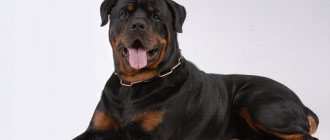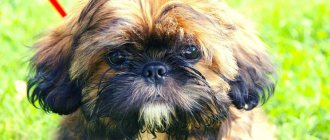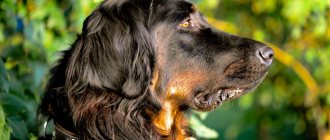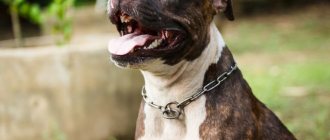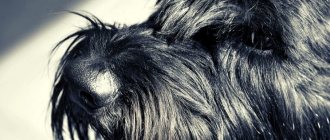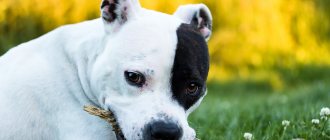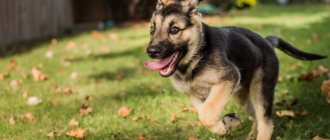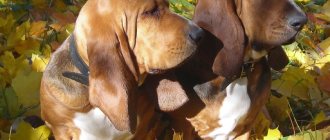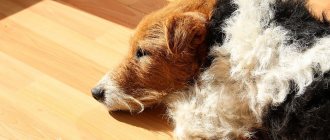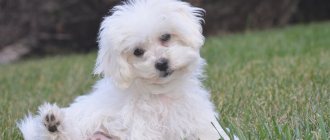History of the Molossians
Molossians are rightfully considered one of the oldest dogs on the planet. Long before the beginning of our era, they lived among the Assyrians, Sumerians and Phoenicians, from where, according to a stable version, they came to the ancient Romans and gained enormous popularity here. Gigantic dogs were used for spectacular bloody battles, protection, and hard work.
This ancient figurine (Mesopotamia, 2nd millennium BC) accurately depicts the outline of a Molossian, although its paws are missing
Already in those ancient times, folk selection of various Molosser breeds began - people selected dogs for their specific needs and bred them. Subsequently, the history of any of the Molossoid breeds was not easy, it knew its ups and downs. Many of them have been under threat of complete extinction more than once - only in the last century this happened twice, after the First and Second World Wars.
Health
Characteristic diseases
Representatives of this breed are not susceptible to allergies, but have a certain set of ailments:
• Abdominal bloating • Hypothyroidism • Glaucoma • Demodicosis • Hip dysplasia • Cardiomyopathy • Cataract • Cutaneous histiocytoma • Interdigital dermatitis (pododermatitis) • Osteosarcoma • Lick granuloma • Aortic stenosis
The Great Dane is an intelligent and quick-witted dog that knows how to get along with children.
Vaccinations
The first vaccination is carried out at two months of age against hepatitis, glanders, parmovirus and leptospirosis;
2nd – three weeks after the first, then they are vaccinated against these 4 diseases once a year;
At 3.5 months, a vaccination is given only against leptospirosis, it is repeated every six months.
Periodically, especially before vaccination, deworming is done.
Before getting such a pet, keep in mind that he will need a large sleeping bed
General Features
The ancient, terrifying giant dogs became the ancestors of many modern breeds, including quite miniature ones. But even in a small pug or a funny Frenchie, the signs of their great ancestors are clearly visible.
Appearance
Molosser dog breeds have common exterior features that are distinctive for the entire group:
- impressive dimensions;
- drooping ears;
- sagging skin,
- powerful jaws;
- massive head;
- strong bones;
- tired-wise look.
One Molosser would have enough skin for two or three dogs.
Intelligence
Molossians are very smart, and they seem to know it. These dogs do not rush to carry out a command, but prefer to think it over thoroughly in order to then make the only correct decision. For this reason, they may not find a common language with every trainer, but they will learn and work well with the one who is truly respected.
It’s already scary - but he hasn’t bitten anyone yet
Health
But these wonderful dogs were not lucky with their health. Large breeds are very difficult to raise, however, smaller ones also have problems with their paws, with the formation of bone and cartilage tissue, and joint pathologies, the most common and serious of which is dysplasia.
Dogs with a short muzzle have difficulties with breathing, and subsequently with the cardiovascular system. Digestive disorders often occur; Molossians are also susceptible to such dangerous pathologies as gastric volvulus.
Every Molosser is a godsend for the veterinarian
Table: pros and cons of keeping moloss dogs
| Advantages of Molossians | Disadvantages of Molossians |
|
|
Giant dogs show touching tenderness towards children
Appearance and character
All dog breeds included in the Molossian group have common features both in appearance and in their temperament.
A dog whose eyes fall out: a review of breeds
Appearance:
- Tall (up to 65 cm);
- Powerful, athletic body;
- Loose skin;
- Strong jaw;
- Droopy ears;
- Tired, sad look.
Character:
- Self confidence;
- Kindness towards others;
- Calm;
- Devotion;
- Fearlessness;
- Intelligence.
Important! The negative aspect of Molosser dogs is their poor health and short life expectancy.
Varieties of Molosser dog breeds
Many dog breeds belong to the molossoid type - although they have significant similarities in appearance and character, they are very diverse. A small, adorable pug, a sporty boxer, and a giant mastiff - there are plenty to choose from.
They are both Molossians - a huge mastiff and a baby pug
German dog
Noble and majestic giants - Great Danes - are full of self-esteem and will take revenge on anyone who dares to encroach on them. In the family, the dog develops the most tender relationships, especially with children.
Great Dane - this breed was the most favorite of the great Alexander the Great
Saint Bernard
The handsome St. Bernard is a rescuer in his main purpose, but his character is far from being as soft and fluffy as his appearance. These dogs are temperamental, touchy, love and know how to fight.
Saint Bernard was named after the monastery of Saint Bernard in the Alps
Cane Corso
The Cane Corso is a reliable protector of your family, fearless, intelligent and loyal. But raising such a dog will have to be systematically dealt with throughout its entire life, starting from early puppyhood.
The Cane Corso dog is one of the most ancient representatives of the Molosser group.
Mastiffs
The subgroup includes several breeds of mastiffs: Neapolitan, Tibetan, English and others. They are distinguished by their huge size, independent but loyal character and, unfortunately, short life expectancy.
Mastiffs can be both the best defenders and guards, and dangerous fanged monsters
Caucasian Shepherd Dog
Caucasian Shepherds are territorial guard dogs and excellent shepherds. They are used to making and implementing important decisions on their own, so learning problems may arise.
Caucasian Shepherds can be excellent protectors and are not at all afraid of frost.
Rottweiler
The Rottweiler is one of the brightest and most effective service breeds. But it is highly desirable that such dogs end up only in experienced hands.
The Rottweiler is a magnificent service dog and simply a very impressive dog.
Dogue de Bordeaux
The Dogue de Bordeaux is also a mastiff, but of French origin. A bully, a cunning and a glutton, but overall incredibly charming - I just want to call him Porthos.
The Dogue de Bordeaux is, first of all, strength, power and enormous, frightening size.
Newfoundland
Newfoundland, which we often call a diver, specializes in water rescue. Swims excellently and has a special quality water-repellent coat. The character is Nordic, not at all cutesy.
Newfoundlands have a calm and inquisitive character and are easy to train.
German boxer
The German Boxer is a medium-sized (for a Molosser) dog with a fit, athletic build. Temperamental, smart, well trained, a little stubborn - but this does not spoil him.
The German Boxer is a special breed, characterized by its square format and muscular body.
English bulldog
This short-legged, big guy can show excellent qualities as a watchman and bodyguard, and not just a companion. Keeping English bulldogs is not difficult, and a city apartment is quite suitable for them - the main thing is that it is not too hot.
The English Bulldog is a good watchdog and companion dog.
Shiba Inu
The Shiba Inu is the smallest of the six native Japanese breeds, but this is not equivalent to the concept of “indoor”. The dog's height is up to 40 cm, and its weight is up to 14 kg. This is just a charming pet with thick plush fur, smart, inquisitive, and also able to smile (at least, this impression is created due to the special cut of its mouth). But this breed is quite capricious, so beginners should not try their hand at it right away; it is advisable to choose someone with a gentler character. The Shiba Inu requires an owner who is confident and strong in character, and even then he will check from time to time to see if the place of the leader of the pack has become available.
The Shiba Inu recognizes only one person as the leader; they keep a distance from the others.
This is a breed of passionate hunters who, in the heat of the chase, do not hear or see anything around them except their prey. Therefore, within the city limits it is better not to let your pet off the leash.
Dogue de Bordeaux
These animals are considered one of the most prominent representatives of the molossoid group. Dogs of this breed weigh 40-50 kilograms and are 58-68 centimeters tall. The main distinguishing feature of the Dogue de Bordeaux is considered to be a massive head with powerful thick jaws and a pronounced transition from the forehead to the muzzle.
The body of these dogs is covered with short, soft hair. They are characterized by a solid black and piebald, golden or fawn color. The presence of white spots on the paws and chest of the animal is not considered a defect.
Dogues de Bordeaux are not suitable for keeping in city apartments; they need space. In addition, these animals are lazy by nature. Therefore, they need regular long walks and moderate physical activity. Otherwise, the dog will quickly gain weight, which can lead to serious health problems.
Bullmastiff
This is a fairly young breed, the birthplace of which is England. These animals were bred by crossing a bulldog with a mastiff. They were recognized as a full-fledged breed in the 20s of the last century.
These huge, powerful animals instantly become the center of everyone's attention. Bullmastiffs are characterized by well-developed muscles and a wide, powerful chest. The main characteristic feature of these dogs is considered to be a wide square skull with a short muzzle and a wide nose.
The bullmastiff's angular, dense body is covered with smooth, short, close-fitting fur of a brownish-red color. Sometimes there are small white spots on it. The height of these dogs reaches 60-69 centimeters, weight – 45-60 kilograms.
Animals of this breed are suitable for keeping in city apartments and private homes. These massive dogs have a rather lazy character. If they are not persistently pushed towards the door, they will continue to lie on the sofa. Training bullmastiffs is complicated by the fact that they are very capricious. The dog will never carry out a command that, in its opinion, is meaningless.
Psychology
The aristocratic slowness of Great Danes should not be overestimated; they love to play and can be quite reckless.
Such entertainment for giants is not always safe, since they can knock anyone down on purpose.
Among the qualities with which the Great Dane dog wins hearts are the following:
• Tenderness. Yes Yes exactly! These giants are so courteous and courteous that, despite their size, they can, like bullmastiffs and beaucerons, behave quite delicately with children.
• Courage. Due to this quality, these noble dogs are well suited for the role of watchdogs. They do not bark very loudly, because, like the Dogue de Bordeaux, their main trump card is size and strength.
• Energy. These animals love physical activity. Running after a flying saucer or a stick is incredible fun for them!
Great Danes are full of energy, they love to frolic in the fresh air• Easy to train. These dogs quite easily perceive the fact that they constantly need to obey someone. Training and the learning process bring them great joy.
• Good memory. Although the owner will periodically need to be reminded who the leader is, Great Danes remember all commands and desired behavior in different circumstances without much effort.
• Moderate independence. If a situation arises when the dog needs to make a decision himself, he is ready to do it perfectly.
• Insight. Great Danes quickly “calculate” the intentions of the person standing in front of them: whether they are good or evil. The dog will very carefully study the behavior and character of each person, building an appropriate line of behavior with him.
• Highly adaptable. If you decide to go with your Great Dane to a country house for a couple of months in the summer, the dog will quite easily accept new circumstances and rules.
• Sociability. Although the dog will not impose his company when the owner is not in a good mood, he still really needs communication
It is important for these giants to feel like full-fledged members of the family
The color of the Great Dane has some influence on the temperament. Thus, it was noticed that black dogs are calmer, while fawn dogs are more active and playful.
The Great Dane knows a lot about stylish accessories
